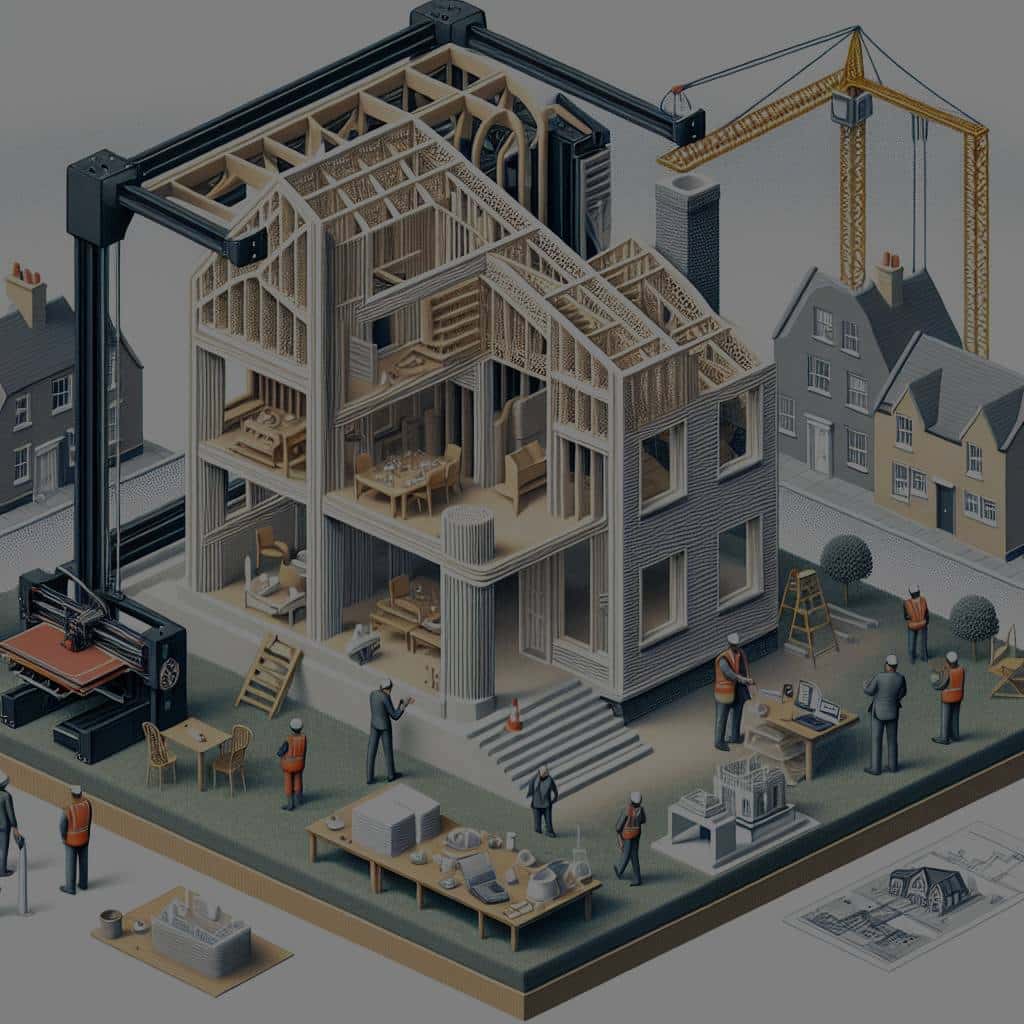What Is the Potential of 3D House Printing in the UK Construction Industry?

The potential of 3D printing in the construction industry continually garners significant attention from industry stakeholders and observers. The technology promises to revolutionize the construction process, yielding new efficiencies, reducing costs, and enabling unprecedented design possibilities. This article aims to delve deeper into the potential of 3D printing, specifically in house construction, within the UK market.
Exploring 3D Printing Technology in the Construction Industry
3D printing, or additive manufacturing, is a process in which materials are selectively deposited to construct an object layer by layer. In the construction industry, this often involves the use of concrete or another building material, which is layered according to digital 3D model specifications. This technology offers numerous benefits, among which are substantial cost reductions, faster construction times, and the potential for more creative designs.
This might interest you : How to Implement Cross-Cultural Marketing for UK Brands Abroad?
The 3D printing in the construction industry is currently in its early stages. However, several projects across the world have already demonstrated its potential. For instance, a company in China managed to print 10 houses in just 24 hours, while a Dutch project unveiled an entirely 3D printed concrete bridge. These pioneering projects serve as an inspiration for industry players, including those in the UK.
The Current State of the UK Construction Market
To understand the potential of 3D printing in the UK’s construction industry, it’s crucial to appreciate the current state of the market. The UK construction industry is a significant sector, contributing about 6% to the national GDP. It’s characterized by a steady demand for new homes, driven by population growth and urbanization trends.
Have you seen this : How to Create a Robust Disaster Recovery Plan for UK IT Companies?
Despite its significance, the industry is plagued by several challenges. The cost of construction materials has been on the rise, squeezing the profitability of construction projects. The sector is also grappling with labor shortages, which slow down projects and escalate costs.
Against this backdrop, the potential of 3D printing technology to address these issues becomes apparent. By automating the building process and reducing reliance on traditional construction materials, 3D printing presents an opportunity to transform the UK construction industry fundamentally.
The Forecasted Growth of 3D Printing in the UK Construction Sector
Given the inherent benefits of 3D printing technology and the pressing needs of the UK construction industry, it is projected that the uptake of 3D printing in the sector will accelerate. Market research estimates suggest that the global 3D printing in construction market will grow at a compound annual growth rate of over 16% between 2020 and 2025.
This forecasted growth is driven by several factors. One of them is the increasing recognition of the cost and time benefits offered by 3D printing. In addition to that, the anticipated technological advancements will enable more extensive use of the technology, thus contributing to its popularity.
The Potential Impact of 3D Printing on UK Homes and Buildings
So, how might 3D printing technology shape the future of homes and buildings in the UK? Several potential impacts can be identified. The first is the potential for cost reductions. Adopting 3D printing could lead to significant savings on construction costs, particularly in labor and materials.
Then, there’s the speed of construction. 3D printing technology can notably shorten the construction timeline, allowing homes and buildings to be erected in days or weeks rather than months. This increased speed can result in further cost savings and enable a faster response to housing demand.
Beyond cost and time savings, 3D printing also holds the potential to revolutionize building design. With the technology, architects and designers can push the boundaries of creativity, realizing intricate designs that would be challenging, if not impossible, to create using traditional construction methods.
The End Users: Embracing a New Building Process
The potential of 3D printing in the construction industry largely hinges on its acceptance by end users – the people who will live and work in the printed buildings. Convincing potential homeowners and property developers to trust a new construction process will be challenging, yet crucial.
Early indications suggest that acceptance of 3D printed homes and buildings may not be as far off as one might think. Several 3D printed buildings around the world are already occupied, and there is a growing appreciation for the unique aesthetic possibilities offered by the technology. As more 3D printed buildings pop up and the benefits of the technology become more apparent, it’s likely that more end users will be willing to consider 3D printed homes and buildings.
The potential of 3D printing in the UK construction industry is indeed vast. From cost and time savings to revolutionary design possibilities, the technology promises to transform the way we construct homes and buildings. The road ahead is lined with challenges, but with continued technological advancements and user acceptance, 3D printing could well become a mainstay in the UK construction industry.
The Global Context: 3D Printing Construction Industry Around the World
As we explore the potential of 3D printing in the UK construction industry, it’s instructive to take a look at the global context. The application of 3D printing technology in construction is not confined to a few countries. In fact, regions like Asia Pacific, North America, and South America have seen some remarkable strides in this domain.
In South Korea, for instance, local companies have successfully printed residential buildings, showcasing the possibility of creating habitable structures using this technology. In the Asia Pacific region, the market size for 3D printing in construction has been growing steadily, driven by rapid urbanization, increasing infrastructure projects, and favorable government policies. The same trend is visible in North America where the uptake of 3D printing technology in construction projects is on the rise.
Furthermore, market forecasts suggest that the global printing construction industry will continue to expand during the forecast period, driven by technological advancements and increasing awareness about the benefits of 3D printing. Notably, health safety factors are also acting as a catalyst for market growth. Since 3D printed homes require less human labor, they reduce the risk of construction-related injuries and accidents.
Regulatory Scenario: Health, Safety, and Compliance in 3D Printed Construction
The potential of 3D printing in the UK construction industry is not just about technological possibilities. It’s also about aligning with regulatory requirements and ensuring health and safety standards are met. In any construction project, adherence to building regulations is critical. Therefore, any new technology, such as 3D printing, must conform to existing regulations or inspire new ones that preserve safety and compliance.
In the UK, health and safety are paramount in construction. Any new building construction method, including 3D printing, would need to comply with the Construction (Design and Management) Regulations 2015 (CDM 2015), among others. These regulations aim to improve health and safety in construction and apply to the whole project, from the planning phase through to completion.
3D printing construction projects will also have to adhere to building codes that cover aspects such as structural integrity, fire safety, and energy efficiency. It’s important to note that as 3D printing in construction becomes more prevalent, we might see new regulations specifically designed for this type of construction.
Conclusion: The Future of 3D Printing in UK’s Construction Industry
The future of 3D printing in the UK construction industry indeed looks promising. As the technology continues to evolve, the possibilities for its application are expanding. From reducing the cost and duration of construction projects, to transforming building design and addressing health safety concerns, 3D printing holds the potential to significantly disrupt the traditional construction market.
However, it’s important to note that the journey towards widespread adoption of 3D printing in construction is not without its challenges. Aside from technological hurdles, there are regulatory considerations, market acceptance issues, and the need for skilled personnel to operate and maintain the printers. But as shown by experiences in other regions such as Asia Pacific, North America, and South America, these challenges are not insurmountable.
In conclusion, the potential of 3D printing in the UK construction industry is vast and multi-faceted. With continued technological progress, regulatory alignment, and market acceptance, the UK construction market could soon experience the transformative impact of 3D printing. It offers hope for the creation of cost-efficient, safe, and uniquely designed homes and buildings, answering to the pressing need for sustainable and efficient construction methods in the UK.
